The authors of Power Systems Analysis claim that \begin{align} |V_S| = |V_{R,NL}| \end{align} where VS is the sending-end voltage, VR is the receiving-end voltage, and VR,NL is the receiving-end voltage when there is no load. How can the magnitudes of the sending-end and receiving-end voltages ever be the same when there is clearly a line impedance (Z = R + jwL) separating VS and VR?
2 Answers
Easily.
Please note carefully that the equation is for no-load receiving end voltage. So it does not apply when there is a load connected.
That's a transmission line with resistance and inductance, and under no-load conditions there is no current, so there is no drop due to resistance, and because there is no changes in current either, there will be no voltage drop over inductance.
The transmission line is also said to be "short", which means time of flight for the signal is ignored and the transmission line is just modeled with lumped RL component model.
- 127,425
- 3
- 97
- 261
Well, assuming that the load is purely resistive and let's call it \$\text{R}_\text{L}\$. Then we can see that the complex input impedance, \$\underline{\text{Z}}_{\space\text{i}}\$, of the circuit is given by:
$$\underline{\text{Z}}_{\space\text{i}}=\text{R}+\text{j}\omega\text{L}+\text{R}_\text{L}\tag1$$
So, the complex input current is given by:
$$\underline{\text{I}}_{\space\text{i}}=\frac{\underline{\text{V}}_{\space\text{i}}}{\underline{\text{Z}}_{\space\text{i}}}\tag2$$
So, we can see that the complex voltage across the load as follows:
$$\underline{\text{V}}_{\space\text{R}_\text{L}}=\underline{\text{I}}_{\space\text{i}}\cdot\underline{\text{Z}}_{\space\text{R}_\text{L}}\tag3$$
So, we get:
$$\underline{\text{V}}_{\space\text{R}_\text{L}}=\frac{\underline{\text{V}}_{\space\text{i}}}{\text{R}+\text{j}\omega\text{L}+\text{R}_\text{L}}\cdot\text{R}_\text{L}\tag4 $$
So, for the magnitude, we get:
\begin{equation} \begin{split} \left|\underline{\text{V}}_{\space\text{R}_\text{L}}\right|&=\left|\frac{\underline{\text{V}}_{\space\text{i}}}{\text{R}+\text{j}\omega\text{L}+\text{R}_\text{L}}\cdot\text{R}_\text{L}\right|\\ \\ &=\frac{\left|\underline{\text{V}}_{\space\text{i}}\right|}{\left|\text{R}+\text{j}\omega\text{L}+\text{R}_\text{L}\right|}\cdot\left|\text{R}_\text{L}\right|\\ \\ &=\frac{\text{V}_{\space\text{source}}}{\sqrt{\left(\text{R}+\text{R}_\text{L}\right)^2+\left(\omega\text{L}\right)^2}}\cdot\text{R}_\text{L}\\ \\ &=\frac{\text{V}_{\space\text{source}}\text{R}_\text{L}}{\sqrt{\left(\text{R}+\text{R}_\text{L}\right)^2+\left(\omega\text{L}\right)^2}}\\ \\ &=\text{V}_{\space\text{source}}\cdot\frac{\sqrt{\text{R}_\text{L}^2}}{\sqrt{\left(\text{R}+\text{R}_\text{L}\right)^2+\left(\omega\text{L}\right)^2}}\\ \\ &=\text{V}_{\space\text{source}}\cdot\sqrt{\frac{\text{R}_\text{L}^2}{\left(\text{R}+\text{R}_\text{L}\right)^2+\left(\omega\text{L}\right)^2}}\\ \\ &=\text{V}_{\space\text{source}}\cdot\sqrt{\frac{\text{R}_\text{L}^2}{\text{R}^2+\text{R}_\text{L}^2+2\text{R}\text{R}_\text{L}+\left(\omega\text{L}\right)^2}}\\ \\ &=\text{V}_{\space\text{source}}\cdot\sqrt{\frac{\displaystyle\frac{\text{R}_\text{L}^2}{\text{R}_\text{L}^2}}{\displaystyle\frac{\text{R}^2}{\text{R}_\text{L}^2}+\frac{\text{R}_\text{L}^2}{\text{R}_\text{L}^2}+\frac{2\text{R}\text{R}_\text{L}}{\text{R}_\text{L}^2}+\frac{\left(\omega\text{L}\right)^2}{\text{R}_\text{L}^2}}}\\ \\ &=\text{V}_{\space\text{source}}\cdot\sqrt{\frac{\displaystyle1}{\displaystyle\left(\frac{\text{R}}{\text{R}_\text{L}}\right)^2+1+\frac{2\text{R}}{\text{R}_\text{L}}+\left(\frac{\omega\text{L}}{\text{R}_\text{L}}\right)^2}}\\ \\ &=\text{V}_{\space\text{source}}\cdot\frac{\displaystyle1}{\sqrt{\displaystyle1+\left(\frac{\text{R}}{\text{R}_\text{L}}\right)^2+\frac{2\text{R}}{\text{R}_\text{L}}+\left(\frac{\omega\text{L}}{\text{R}_\text{L}}\right)^2}} \end{split}\tag5 \end{equation}
Now, an open circuit (with no lead) means \$\text{R}_\text{L}\space\to\space\infty\$ which gives:
\begin{equation} \begin{split} \lim_{\text{R}_\text{L}\space\to\space\infty}\left|\underline{\text{V}}_{\space\text{R}_\text{L}}\right|&=\lim_{\text{R}_\text{L}\space\to\space\infty}\text{V}_{\space\text{source}}\cdot\frac{\displaystyle1}{\sqrt{\displaystyle1+\left(\frac{\text{R}}{\text{R}_\text{L}}\right)^2+\frac{2\text{R}}{\text{R}_\text{L}}+\left(\frac{\omega\text{L}}{\text{R}_\text{L}}\right)^2}}\\ \\ &=\lim_{\text{R}_\text{L}\space\to\space\infty}\text{V}_{\space\text{source}}\cdot\frac{\displaystyle1}{\sqrt{\displaystyle1+\left(0\right)^2+0+\left(0\right)^2}}\\ \\ &=\text{V}_{\space\text{source}} \end{split}\tag6 \end{equation}
- 7,203
- 12
- 21
